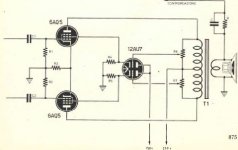The ends of T1 will swing above B+, the triode cannot follow. It provides for adjustable UL or Triode feedback, but less than half wave. The results might not behave exactly as intended.
Such feedback will fight the pentode from entering saturation, but would do nothing to fight the pentode from entering cutoff. It might be some bizarre sort of Class AB crossing scheme?
Might have been better if a Triode strap resistor fed screen directly from plate, and 12AU7 shunted excess current away? No, even that doesn't work full cycle. What was I thinking?
Such feedback will fight the pentode from entering saturation, but would do nothing to fight the pentode from entering cutoff. It might be some bizarre sort of Class AB crossing scheme?
Might have been better if a Triode strap resistor fed screen directly from plate, and 12AU7 shunted excess current away? No, even that doesn't work full cycle. What was I thinking?
Last edited:
Glad you agreeI think the quick answer is that it doesn't work. It might work if the triode anode had a much higher voltage, about twice the supply voltage.
Bootstrapping the plates of the screen driver to the respective output tube plates might work, but now we're actually consuming power out of the primary, rather than aiding it. A neat thought, but hardly practical as shown. OTOH, I think ARC in fact did something along these lines (UL w/o UL taps), using Mosfets as screen drivers.
Dave
Dave
There was some talk and even a few experiments along these lines in this thread. I breadboarded my circuit, but it still sits on a shelf awaiting further attention.
http://www.diyaudio.com/forums/tubes-valves/97384-adjustable-distributed-load-discussion.html
http://www.diyaudio.com/forums/tubes-valves/97384-adjustable-distributed-load-discussion.html
The ends of T1 will swing above B+, the triode cannot follow. It provides for adjustable UL or Triode feedback, but less than
half wave.
It is true that the screen voltage won't track the output signal for a full wave but in class-AB the output tube will not conduct current at those times so I don't see how this would really hinder the operation. In fact, doesn't the screen stop drawing any current even in a "real" ultralinear circuit even though the voltage at the screen does swing a full cycle? Essentially, I see the triode being capable of buffering the screen current at the times when it is actually needed to do so. ...In class-AB circuit that is; with class-A bias the incapability to swing a full wave might prove to be a problem.
Last edited:
In fact, doesn't the screen stop drawing any current even in a "real" ultralinear circuit even though the voltage at the screen does swing a full cycle?
Screen operates by virtue of Voltage. Current is a side effect, and actually steals away from what the cathode might otherwise emit toward the plate. Even so, this opposing parasitic effect is far less than the effect of screen Voltage upon plate current.
To suggest that a screen stops drawing current, therefore screen Voltage ceases to have influence the remainder of the phase, does not reflect reality.
On the other hand, if your comment was aimed at what happens after plate (rather than screen) current cutoff in AB. That theory might hold water.
Its worth investigating (at least run a sim) how this shapes an AB crossing? Does it make matters better or worse than the standard pentode crossing? If worse, only then we might scratch AB off the list.
Last edited:
- Status
- This old topic is closed. If you want to reopen this topic, contact a moderator using the "Report Post" button.
- Home
- Amplifiers
- Tubes / Valves
- Ultralinear but no UL taps.
